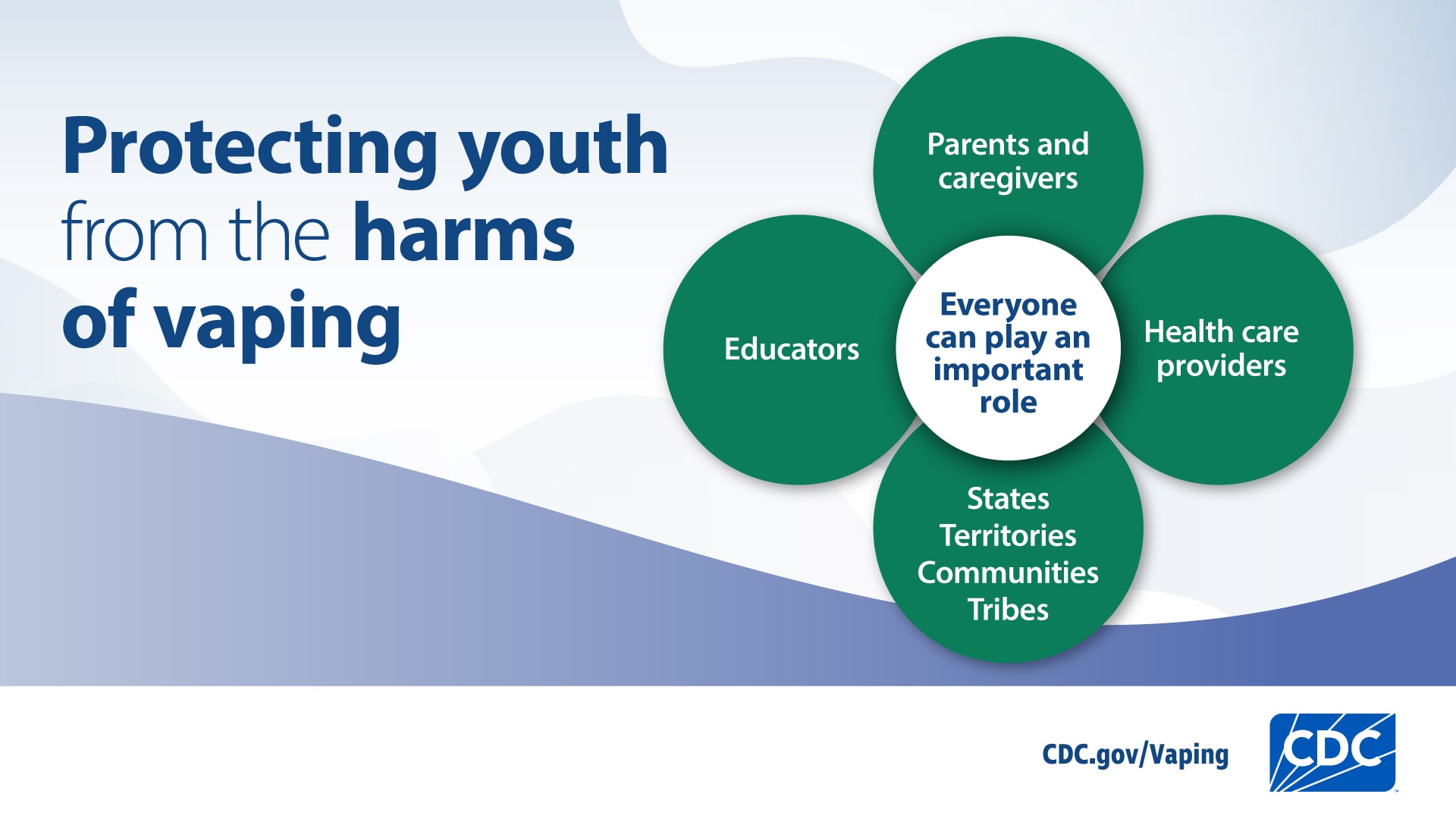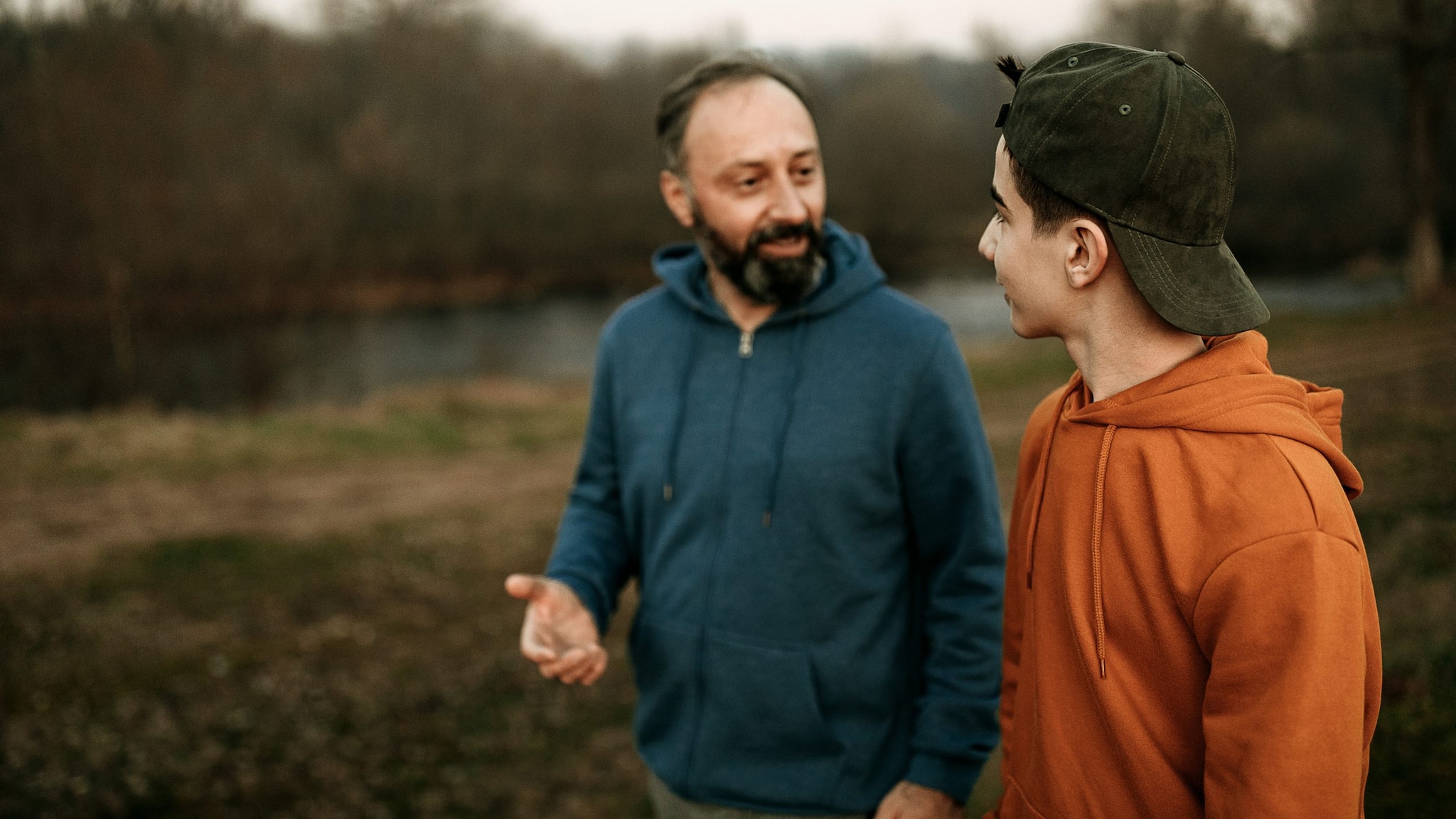What to know
Individuals and organizations can play an important role in helping youth reject or quit vaping and all other tobacco products. Working together will help ensure that all youth live healthy, tobacco-free lives.
Everyone plays a role

Parents and caregivers
There are many ways parents and caregivers can help protect their children from vaping.
- Set a good example for youth by being tobacco-free. If you use tobacco, it's never too late to quit. For free help, visit CDC.gov/Quit or call 1-800-QUIT-NOW.
- Make your home tobacco-free. Ensure your child is not exposed to secondhand smoke or aerosol from any tobacco products, including vapes.
- Talk to your child or teen about why vaping is harmful to them. Ask them to stay away from all tobacco products, including vape products, because none are safe. It's never too early or too late to start these conversations.
- Talk to teachers or school administrators about their tobacco prevention curriculum and enforcement of tobacco-free policies. Ask whether they offer alternatives to suspension.
- If your child vapes, encourage and support them to quit. Talk to their health care provider about getting quitting help. You can also call 1-800-QUIT-NOW and visit Teen.smokefree.gov for more help.
- Download this fact sheet to learn more: E-Cigarettes and Youth: What Parents Need to Know
How to talk with your child about vapes

Before starting the conversation
Know the facts.
- Get credible information about youth vaping at CDC.gov/Vaping.
- Ask your child's health care provider for information or schedule an appointment to talk about the risks of vaping.
Start the conversation
Create a safe space for discussion.
- Be patient and listen.
- Avoid criticism.
- Remember, your goal is to have a conversation, not deliver a lecture.
- Keep the conversation open and flexible as your children get older.
Choose your moments. Your child will be more likely to listen if the discussion feels natural. Avoid saying "we need to talk." Instead, ask your child what they think about something you see together, such as:
- Someone using a vape, either in person or on a screen.
- A vape shop or store display for vape products.
- Vape product advertisements.
Ask for support.
- Supportive adults can help reinforce your message.
- Encourage your child talk with other trusted adults who are aware of the risks of vaping. This could include relatives, teachers, faith leaders, coaches, counselors, or others.
- Suggest they talk with their health care provider, such as their doctor, dentist, or school nurse.
Answer their questions
Your child may have questions about vaping. Here are some ideas to help you answer them.
Why don’t you want me to vape?
- Science shows that vapes contain ingredients that are addictive and could harm different parts of your body.
- Right now, your brain is still developing, which means you can get addicted more easily than an adult could. Most vape products contain nicotine, and using nicotine can change your brain.
- Being addicted to nicotine is stressful. When your brain craves nicotine, you can feel depressed, anxious, and irritable and can have trouble concentrating and sleeping. I don’t want that for you!
- Vape products contain chemicals that are harmful. If you vape, you’ll breathe in tiny particles that can harm your lungs.
- I know you wouldn’t want to harm your friends or family. The cloud people exhale when vaping can expose those around them to chemicals that are not safe to breathe.
What’s the big deal about nicotine?
- Your brain is still developing until about age 25. Science shows that nicotine is addictive and can harm your brain development.
- Using nicotine at your age may make it harder for you to concentrate, learn, or control your impulses.
- Nicotine can even train your brain and make you more vulnerable to other drug addictions.
- Using nicotine at your age may make it harder for you to concentrate, learn, or control your impulses.
- Nicotine addiction is one more source of stress you don’t need.
- Over time, nicotine changes how your brain works and makes it seem like you need nicotine just to feel okay.
- When you stop using it, you may experience nicotine withdrawal. This means your brain could get irritable. You may get anxious or upset, have a hard time concentrating or sleeping, have strong urges to vape, or just feel uncomfortable.
- Over time, nicotine changes how your brain works and makes it seem like you need nicotine just to feel okay.
- Vaping can be expensive. Think of all the other ways you might be able to spend your money.
- I don’t say this to scare you, but I want you to have the facts. Nothing is more important to me than your health and safety.
I thought vape products didn’t contain nicotine—just water and flavoring?
- I used to think that too. But e-cigarette aerosol is not harmless “water vapor.” Most vape products have nicotine. They also have other substances that can be harmful, including chemicals known to cause cancer and tiny particles that can be inhaled deep into the lungs.
- Let’s look at some webpages about vaping.
Aren’t vapes (e-cigarettes) safer than regular cigarettes?
- Your brain is still developing. Scientific studies show that it isn't safe for you to use any tobacco product that contains nicotine, including vapes.
- Whether you get nicotine from a vape or a regular cigarette, it’s still risky.
- Some vape device batteries have even exploded and hurt people.
I (or my friends) have tried vaping, and it was no big deal
- I appreciate your honesty. In the future, I hope you (or your friends) will stay away from vapes and other tobacco products, including cigarettes. Science shows that vape products contain ingredients that are addictive and could harm different parts of your body.
- You may think that everyone is vaping, but that's not the case. Most young people do not vape or use other tobacco products—and most students who vape want to quit.
- Let's look at some webpages about the health effects of vaping.
- Next time we go to the doctor, let’s ask what they think about the risks of nicotine, vapes, and other tobacco products.
You used tobacco, so why shouldn’t I?
- If I could live my life over again, I never would have started smoking. I have learned that people who smoke cigarettes are much more likely to develop, and die from, diseases than people who don't smoke.
- Quitting was really hard, and I don't want you to go through that. The best thing is to not start at all.
Educators

As an educator, coach, or school administrator, you have an important role in protecting students from vaping.
- Learn about the risks of vape use for young people and the different types of vape devices.
- Discuss the dangers of vaping with your students.
- Be supportive. Encourage students to quit tobacco use and help connect them to quitting resources.
- Implement prevention programs that are free from tobacco industry influence.
- Develop, implement, and enforce tobacco-free school policies which address all product types.
- Learn about school policies supporting students to quit tobacco use as an alternative to suspension.
- Take advantage of free resources, including this How to Talk to Students About Vaping conversation card.
Health care providers

Take the following actions with your young patients and their caregivers to help protect them from vaping.
- Ask all adolescent patients if they use any tobacco products, including e-cigarettes.
- If they do, consider treatment options.
- AAP’s Youth Tobacco Cessation: Considerations for Clinicians provides detailed information you can use to help youth quit. See AAP cessation resources for more tools.
- Free resources are available to support quitting, such as 1-800-QUIT-NOW and Teen.smokefree.gov.
- AAP’s Youth Tobacco Cessation: Considerations for Clinicians provides detailed information you can use to help youth quit. See AAP cessation resources for more tools.
- Read E-Cigarettes and Youth: What Health Care Providers Need to Know fact sheet to learn about vapes and the risks to youth.
- Use the Health Care Provider Conversation Card to educate patients about the risks of e-cigarettes.
States, tribes, communities, and territories
We know what works to reduce youth initiation of tobacco products. CDC supports comprehensive tobacco prevention and control programs in states and communities. These programs use proven interventions to prevent young people from starting to use tobacco products, including e-cigarettes.
States, tribes, communities, and territories can:
- Increase the price of tobacco products, including e-cigarettes, which is one of the most effective ways to prevent youth initiation.12
- Implement comprehensive smokefree policies that prohibit the use of all tobacco products in indoor areas of all public places. These policies protect everyone from harmful secondhand smoke and aerosol exposure.1
- Require tobacco retailers to have a license to sell tobacco products. Retail licenses help states and communities know who is selling tobacco products.1 This helps them enact and enforce policies that prevent youth access and initiation.
- There is no evidence that laws punishing youth for tobacco product possession, use, or purchase are effective in reducing youth tobacco use.2
- States and communities can implement policies that place the responsibility of preventing youth access on retailers and the tobacco industry, rather than penalizing youth.
- There is no evidence that laws punishing youth for tobacco product possession, use, or purchase are effective in reducing youth tobacco use.2
- Prohibit the sale of tobacco products, including flavored products. Flavors are one reason why e-cigarettes and other tobacco products appeal to youth and encourage youth initiation.1
- Reduce the number of retailers that are allowed to sell tobacco products.3
- U.S. Department of Health and Human Services. E-Cigarette Use Among Youth and Young Adults: A Report of the Surgeon General. Centers for Disease Control and Prevention; 2016. Accessed Feb 14, 2024.
- U.S. Department of Health and Human Services. Preventing Tobacco Use Among Youth and Young Adults: A Report of the Surgeon General. Centers for Disease Control and Prevention; 2012. Accessed Feb 14, 2024.
- U.S. Dept of Health and Human Services. Eliminating Tobacco-Related Disease and Death: Addressing Disparities—A Report of the Surgeon General. Centers for Disease Control and Prevention; 2024. Accessed Dec 19, 2024.
